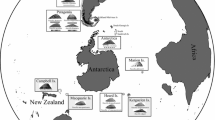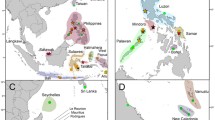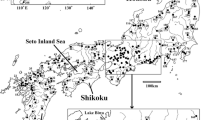Abstract
Because marine species respond differentially to factors governing survival and gene flow, closely related taxa may display dissimilar phylogeographic histories. New data for the patchily distributed gastropod Nassarius nitidus throughout its Atlantic–Mediterranean range (collected during 2008 and 2009) were used to investigate its phylogeography and recent demography. Results based on mitochondrial COI sequences of 422 N. nitidus individuals from 15 localities revealed contrasting phylogeographic and demographic patterns among N. nitidus populations from each basin. Data suggest the existence of two glacial refugia, one in the Atlantic, around the Iberian Peninsula, and the other in the Paleo-Mediterranean Sea (Adriatic). Bayesian skyline reconstructions suggest that the Adriatic population of N. nitidus remained largely unaffected by the Last Glacial Maximum (LGM), whereas the Iberian Atlantic region experienced dramatic exponential growth after its conclusion. Contemporary North Sea populations of N. nitidus are the endpoint of a leading-edge recolonization process from a southern position. Additionally, a reanalysis of pre-existing material for the continuously distributed close congener N. reticulatus was used to compare both species in the late histories. In contrast to N. nitidus, N. reticulatus prospered during the LGM and experienced an earlier Atlantic expansion during the previous interglacial period. Despite similar life history and dispersal potential, the results here presented suggest that subtle differences in microhabitat requirements between the two species have had important consequences for their particular distribution in response to glacial events.




Similar content being viewed by others
References
Addison JA, Hart MW (2005) Colonization, dispersal, and hybridization influence phylogeography o North Atlantic sea urchins (Strongylochntrotus droebachiensis). Evolution 59:532–543
Alvarado Bremer JR, Viñas J, Mejuto J, Ely B, Pla C (2005) Comparative phylogeography of Atlantic bluefin tuna and swordfish: the combined effects of vicariance, secondary contact, introgression, and population expansion on the regional phylogenies of two highly migratory pelagic fishes. Mol Phylogenet Evol 36:169–187
Andersen BG, Borns HW (1994) The ice age world. An introduction to Quaternary history and research with emphasis on North American and Northern Europe during the last 2.5 million years. Scandinavian University Press, Oslo
Andreakis N, Procaccini G, Kooistra WHCF (2004) Asparagopsis taxiformis and Asparagopsis armata (Bonnemaisoniales, Rhodophyta): genetic and morphological identification of Mediterranean populations. Eur J Phycol 39:273–283
Avise JC (2004) Molecular markers, natural history, and evolution. Sinauer Associates, Sunderland
Avise JC, Arnold J, Ball RM, Bermingham E, Lambt T, Neigel JE, Reeb CA, Saunders NA (1987) Intraespecific phylogeography: the mitochondrial DNA bridge between population genetics and systematics. Annu Rev Ecol Syst 18:489–522
Barreiro R, González R, Quintela M, Ruiz JM (2001) Imposex, organotin bioaccumulation and sterility of female Nassarius reticulatus in polluted areas of NW Spain. Mar Ecol Prog Ser 218:203–212
Barroso CM, Moreira MH (1998) Reproductive cycle of Nassarius reticulatus in the Ria de Aveiro, Portugal: implications for imposex studies. J Mar Biol Assoc UK 78:1233–1246
Barroso CM, Moreira MH, Richardson CA (2005) Age and growth of Nassarius reticulatus in the Ria de Aveiro, NW Portugal. J Mar Biol Assoc UK 85:151–156
Bianchi CN, Morri C (2000) Marine biodiversity of the Mediterranean Sea: situation, problems and prospects for future research. Mar Pollut Bull 40:367–376
Bilton DT, Paula J, Bishop DD (2002) Dispersal, genetic differentiation and speciation in estuarine organisms. Estuar Coast Shelf Sci 55:937–952
Campo D, Molares J, Garcia L, Fernandez-Rueda P, García-Gonzalez C, García-Vázquez E (2010) Phylogeography of the European stalked barnacle (Pollicipes pollicipes): identification of glacial refugia. Mar Biol 157:147–156
Carvajal-Rodríguez A, Guerra-Varela J, Fernández B, Rolán E, Rolán-Álvarez E (2006) An example of the application of geometric morphometric tools to the morphological diagnosis of two sibling species in Nassarius (Mollusca, Prosobranchia). Íberus 24:81–88
Chatzinikolaou E, Richardson CA (2008) Population dynamics and growth of Nassarius reticulatus (Gastropoda: Nassariidae) in Rhosneigr (Anglesey, UK). MarBiol 153:605–619
Chevolot M, Hoarau G, Rijnsdorp AD, Stam WT, Olsen JL (2006) Phylogeography and population structure of thornback rays (Raja clavata L., Rajidae). Mol Ecol 15:3693–3705
Clark PU, Mix AC (2002) Ice sheets and sea level of the Last Glacial Maximum. Q Sci Rev 21:1–7
Clark PU, Dyke AS, Shakun JD, Carlson AE, Clark J, Wohlfarth B, Mitrovica JX, Hostetler SW, McCabe AM (2009) The last glacial maximum. Science 325:710–714
Clement M, Posada D, Crandall KA (2000) TCS: a computer program to estimate gene genealogies. Mol Ecol 9:1657–1659
Collyer DM (1961) Differences revealed by paper partition chromatography between gastropod Nassarius reticulatus (L) and specimens believed to be N. nitida (Jeffreys). J Mar Biol Assoc UK 41:683–693
Couceiro L, Barreiro R, Ruiz JM, Sotka EE (2007) Genetic isolation by distance among populations of the netted dog whelk Nassarius reticulatus (L.) along the European Atlantic coastline. J Hered 98:603–610
Couceiro L, Diaz J, Albaina N, Barreiro R, Irabien JA, Ruiz JM (2009) Imposex and gender-independent butyltin accumulation in the gastropod Nassarius reticulatus from the Cantabrian coast (N Atlantic Spain). Chemosphere 76:424–427
Couceiro L, López L, Sotka EE, Ruiz JM, Barreiro (2011) Molecular data delineate cryptic Nassarius species and characterize spatial genetic structure of N. nitidus. J Mar Biol Assoc UK. doi:10.1017/S0025315411000816
Cowen RK, Sponaugle S (2009) Larval dispersal and marine population connectivity. Annu Rev Mar Sci 1:443–466
Coyer JA, Peters AF, Stam WT, Olsen JL (2003) Post-ice age recolonisation and differentiation of Fucus serratus L. (Phaeophyceae; Fucaceae) populations in northern Europe. Mol Ecol 12:1817–1829
Coyer JA, Diekmann OE, Serrao EA, Procaccinin G, Milchakova N, Pearson GA, Stam WT, Olsen JL (2004) Population genetics of dwarf eelgrass Zostera nolti throughout its biogeographic range. Mar Ecol Prog Ser 281:51–62
Craeymeersch J, Rietveld M (2005) Dog whelks in Dutch coastal waters. MarBEF Newsl 3:23–24
Crandall ED, Frey MA, Grosberg RK, Barber PH (2008) Contrasting demographic history and phylogeographical patterns in two Indo-Pacific gastropods. Mol Ecol 17:611–626
Cunningham CW, Collins TM (1998) Beyond area relationships: extinction and recolonization in molecular marine biogeography. In: DeSalle R, Schierwater B (eds) Molecular approaches to ecology and evolution. Birkhäuser Verlag, Basel, pp 297–321
Drummond AJ, Rambaut A (2007) BEAST: Bayesian evolutionary analysis by sampling trees. BMC Evol Biol 7:214
Drummond AJ, Rambaut A, Shapiro B, Pybus OG (2005) Bayesian coalescent inference of past population dynamics from molecular sequences. Mol Biol Evol 22:1185–1192
Duran S, Palacín C, Becerro MA, Turón X, Giribet G (2004) Genetic diversity and population structure of the commercially harvested sea urchin Paracentrotus lividus (Echinodermata, Echinoidea). Mol Ecol 13:3317–3328
Estoup A, Largiader CR, Perrot E, Chourrout D (1996) Rapid one-tube DNA extraction for reliable PCR detection of fish polymorphic markers and transgenes. Mol Mar Biol Biotechnol 5:295–298
Excoffier L, Smouse PE, Quattro JM (1992) Analysis of molecular variance inferred from metric distances among DNA haplotypes: application to human mitochondrial DNA restriction data. Genetics 21:479–491
Excoffier L, Laval G, Schneider S (2005) ARLEQUIN ver. 3.0: an integrated software package for population genetics data analysis. Evol Bioinf Online 1:47–50
Folmer O, Black M, Hoeh W, Lutz R, Vrijenhoek R (1994) DNA primers for amplification of mitochondrial cytochrome c oxidase subunit I from diverse metazoan invertebrates. Mol Mar Biol Biotechnol 3:294–299
Fraser CI, Nikula R, Spencer HG, Waters JM (2009) Kelp genes reveal effects of subantarctic sea ice during the Last Glacial Maximum. PNAS 106:3249–3253
Fretter V, Graham A (1994) British prosobranch molluscs: their functional anatomy and ecology. Ray Society, London
Fu YX (1997) Statistical tests of neutrality of mutations against population growth, hitchhiking and background selection. Genetics 147:915–925
Galarza JA, Carreras-Carbonell J, Macpherson E, Pascual M, Roques S, Turner GF, Rico C (2009) The influence of oceanographic fronts and early-life-history traits on connectivity among littoral fish species. PNAS 106:1473–1478
Gibbard P, Cohen KM (2008) Global chronostratigraphical correlation table for the last 2.7 million years. Episodes 31:243–247
Gysels ES, Hellemans B, Pampoulie C, Volckaert FAM (2004a) Phylogeography of the common goby, Pomatoschistus microps, with particular emphasis on the colonization of the Mediterranean and the North Sea. Mol Ecol 13:403–417
Gysels ES, Hellemans B, Patarnello T, Volckaert FAM (2004b) Current and historic gene flow of the sand goby Pomatoschistus minutus on the European Continental Shelf and in the Mediterranean Sea. Biol J Linn Soc 83:561–576
Hansson HG (1998) NEAT (North East Atlantic Taxa): Scandinavian Marine Mollusca check-list. www.tmbl.gu.se. Accessed 2 May 2011
Harpending HC (1994) Signature of ancient population growth in a low-resolution mitochondrial-DNA mismatch distribution. Hum Biol 66:591–600
Hewitt GM (1996) Some genetic consequences of ice ages, and their role in divergence and speciation. Biol J Linn Soc 58:247–276
Hey J, Nielsen R (2007) Integration within the Felsenstein equation for improved Markov chain Monte Carlo methods in population genetics. PNAS 104:2785–2790
Ho SYW, Shapiro B (2011) Skyline-plot methods for estimating demographic history from nucleotide sequences. Mol Ecol Resour 11:423–434
Hoarau G, Coyer JA, Veldsink JH, Stam WT, Olsen JL (2007) Glacial refugia and recolonization pathways in the brown seaweed Fucus serratus. Mol Ecol 16:3606–3616
Hochberg Y (1988) A sharper Bonferroni procedure for multiple tests of significance. Biometrika 75:800–802
Johannesson K, André C (2006) Life on the margin: genetic isolation and diversity loss in a peripheral marine ecosystem, the Baltic Sea. Mol Ecol 15:2013–2029
Jolly MT, Viard F, Gentil F, Thiébaut E, Jollivet D (2006) Comparative phylogeography of two coastal polychaete tubeworms in the Northeast Atlantic supports shared history and vicariant events. Mol Ecol 15:1841–1855
Kinlan BP, Gaines SD (2003) Propagule dispersal in marine and terrestrial environments: a community perspective. Ecology 84:2007–2020
Kooistra WHCF, Stam WT, Olsen JL, van den Hoek C (1992) Biogeography of Cladophoropsis membranacea (Chlorophyta) based on comparisons of nuclear rDNA ITS sequences. J Phycol 28:660–668
Kyle CJ, Boulding EG (2000) Comparative population genetic structure of marine gastropods (Littorina spp.) with and without pelagic larval dispersal. Mar Biol 137:835–845
Lambeck K (1997) Sea-level change along the French Atlantic and channel coasts since the time of the last glacial maximum. Palaeogeogr Palaeoclimatol Palaeoecol 129:1–22
Luttikhuizen PC, Drent J, Baker AJ (2003) Disjunct distribution of highly diverged mitochondrial lineage clade and population subdivision in a marine bivalve with pelagic larval dispersal. Mar Biol 12:2215–2229
Maggs CA, Castilho R, Foltz D, Henzler C, Jolly MT, Kelly J, Olsen J, Perez KE, Stam W, Vainola R, Viard F, Wares J (2008) Evaluating signatures of glacial refugia for North Atlantic benthic marine taxa. Ecology 89:S108–S122
Mantel N (1967) The detection of disease of clustering and a generalized regression approach. Cancer Res 27:209–220
Marko PB (2002) Fossil calibration of molecular clocks and the divergence times of geminate species pairs separated by the Isthmus of Panama. Mol Biol Evol 19:2005–2021
Marko PB (2004) What’s larvae got to do with it? Disparate patterns of post-glacial population structure in two benthic marine gastropods with identical dispersal potential. Mol Ecol 13:597–611
Nylander JAA (2004) MRMODELTEST v2. Program distributed by the author. Evolutionary Biology Centre, Uppsala University
Olsen JL, Stam WT, Coyer JA, Reusch TBH, Billingham M, Boström C, Calvert E, Christie H, Granger S, la Lumière R, Milchakova N, Oudot-le Secq MP, Procaccini G, Sanjabi B, Serrao E, Veldsink J, Widdicombe S, Wyllie-Echeverria S (2004) North Atlantic phylogeography and large-scale population differentiation of the seagrass Zostera marina, L. Mol Ecol 13:1923–1941
Olsen JL, Zechman FW, Hoarau G, Coyer JA, Stam WT, Valero M, Åberg P (2010) The phylogeographic architecture of the fucoid seaweed Ascophyllum nodosum: an intertidal ‘marine tree’ and survivor of more than one glacial-interglacial cycle. J Biogeogr 37:842–856
Patarnello T, Volckaert FAMJ, Castilho R (2007) Pillars of Hercules: is the Atlantic-Mediterranean transition a phylogeographical break? Mol Ecol 16:4426–4444
Petit RJ, Aguinagalde I, de Beaulieu JL, Bittkau C, Brewer S, Cheddadi R, Ennos R, Fineschi S, Grivet D, Lascoux M, Mohanty A, Muller-Starck GM, Demesure-Musch B, Palme A, Martin JP, Rendell S, Vendramin GG (2003) Glacial refugia: hotspots but not melting pots of genetic diversity. Science 300:1563–1565
Provan J, Bennett KD (2008) Phylogeographic insights into cryptic glacial refugia. Trends Ecol Evol 23:564–571
Provan J, Wattier RA, Maggs CA (2005) Phylogeographic analysis of the red seaweed Palmaria palmata reveals a Pleistocene marine glacial refugium in the English Channel. Mol Ecol 14:793–804
Ramos-Onsins SE, Rozas J (2002) Statistical properties of new neutrality tests against population growth. Mol Biol Evol 19:2092–2100
Raymond M, Rousset F (1995) GENEPOP (Version 1.2): population genetics software for exact tests and ecumenicism. J Hered 86:248–249
Reynolds J, Weir BS, Cockerham CC (1983) Estimation of the coancestry coefficient: basis for a short-term genetic distance. Genetics 150:767–779
Rogers AR, Harpending H (1992) Population growth makes waves in the distribution of pairwise genetic differences. Mol Biol Evol 9:552–569
Rolán E (1992) Dos especies más de moluscos mediterráneos introducidos en la bahía de O Grove. Thalassas 10:135
Rolán E, Bañón R (2007) Primer hallazgo de la especie invasora Rapana venosa y nueva información sobre Hexaplex trunculus (Gastropoda, Muricidae) en Galicia. Not SEM 47:57–59
Rolán E, Luque AA (1994) Nassarius reticulatus (Linnaeus, 1758) y Nassarius nitidus (Jeffreys, 1867) (Gastropoda, Nassariidae), dos especies válidas de los mares de Europa. Íberus 12:59–76
Roman J, Palumbi SR (2004) A global invader at home: population structure of the green crab, Carcinus maenas, in Europe. Mol Ecol 13:2891–2898
Ronquist F, Huelsenbeck J (2003) Mrbayes 3: bayesian phylogenetic inference under mixed models. Bioinformatics 19:1572–1574
Rousset F (1997) Genetic differentiation and estimation of gene flow from F-statistics under isolation by distance. Genetics 145:1219–1228
Rousset F (2008) GENEPOP’007: a complete re-implementation of the GENEPOP software for Windows and Linux. Mol Ecol Resour 8:103–106
Rozas J, Sanchez-DelBarrio JC, Messeguer X, Rozas R (2003) DNASP, DNA polymorphism analyses by the coalescent and other methods. Bioinformatics 19:2496–2497
Ruiz JM, Díaz J, Albaina N, Couceiro L, Irabien JA, Barreiro R (2010) Decade-long monitoring reveals a transient distortion of baseline butyltin bioaccumulation pattern in gastropods. Mar Pollut Bull 60:931–934
Sanjuán A, Pérez-Losada M, Rolán E (1997) Allozyme evidence for cryptic speciation in sympatric populations of Nassarius spp. (Mollusca: Gastropoda). J Mar Biol Assoc UK 77:773–784
Schneider S, Excoffier L (1999) Estimation of past demographic parameters from the distribution of pairwise differences when the mutation rates vary among sites: application to human mitochondrial DNA. Genetics 152:1079–1089
Shanks AL, Grantham BA, Carr MH (2003) Propagule dispersal distance and the size and spacing of marine reserves. Ecol Appl 13:S159–S169
Slatkin M (1995) A measure of population subdivision based on microsatellite allele frequencies. Genetics 137:457–462
Spalding MD, Fox HE, Halpern BS, McManus MA, Molnar J, Allen GR, Davidson N, Jorge ZA, Lombana AL, Lourie SA, Martin KD, McManus E, Molnar J, Recchia CA, Robertson J (2007) Marine ecoregions of the world: a bioregionalization of coastal and shelf areas. Bioscience 57:573–583
Strasser CA, Barber PH (2009) Limited genetic variation and structure in softshell clams (Mya arenaria) across their native and introduced range. Conserv Genet 10:803–814
Swofford DL (2002) PAUP*—Phylogenetic analysis using parsimony* and other methods, version 4. Sinauer Associates, Sunderland
Taberlet P, Fumagalli L, Wust-Saucy AG, Cosson JF (1998) Comparative phylogeography and postglacial colonization routes in Europe. Mol Ecol 7:453–464
Tajima F (1989) Statistical method for testing the neutral mutation hypothesis by DNA polymorphism. Genetics 123:585–595
Tallmark B (1980) Population dynamics of Nassarius reticulatus (Gastropoda: Prosobranchia) in Gullmar Fjord, Sweden. Mar Ecol Prog Ser 3:51–62
Templeton AR, Crandall KA, Sing CF (1992) A cladistic analysis of phenotypic associations with haplotypes inferred from restriction endonuclease mapping and DNA sequence data. III. Cladogram estimation. Genetics 132:619–633
Thomas CD, Cameron A, Green RE, Bakkenes M, Beaumont LJ, Collingham YC, Erasmus BFN, de Siqueira MF, Grainger A, Hughes L, Huntley B, van Jaarsveld AS, Midgley GF, Miles L, Ortega-Huerta MA, Peterson AT, Phillips OL, WilliamS SE (2004) Extinction risk from climate change. Nature 427:145–148
Tintore J, Laviolette PE, Blade I, Cruzado A (1988) A study of an intense density front in the Eastern Alboran Sea: the Almeria-Oran front. J Phys Oceanogr 18:1384–1397
Valli G, Vborgese E, Bussetto E (2003) Ciclo riproduttivo di Nassarius reticulatus (L., 1758), Gastropoda, Prosobranchia in tre stazioni del Golfo di Triestre. Biol Mar Medit 10:190–202
Wares JP, Cunningham CW (2001) Phylogeography and historical ecology of the North Atlantic intertidal. Evolution 55:2455–2469
Wares JP, Gaines SD, Cunningham CW (2001) A comparative study of asymmetric migration events across a marine biogeographic boundary. Evolution 55:295–306
Waters JM, King TM, O’Loughlin PM, Spencer HG (2005) Phylogeographical disjunction in abundant high-dispersal littoral gastropods. Mol Ecol 14:2789–2802
Wilke T, Pfenninger M (2002) Separating historic events from recurrent processes in cryptic species: phylogeography of mud snails (Hydrobia spp.). Mol Ecol 11:1439–1451
Wilke T, Schultheiss R, Albrecht C (2009) As time goes by: a simple fool’s guide to molecular clock approaches in invertebrates. Am Malacol Bull 27:25–45
Williams D, Dunkerley D, DeDecker P, Kershaw P, Chappell M (1998) Quaternary environments. Arnold, London
Wright S (1951) The genetical structure of populations. Ann Eugenic 15:323–354
Acknowledgments
We thank C. Bernárdez, J. Craeymeersch, L. Grassia, L. Kellner, F. Kerchov, B. Lundve and C. Mazziotti for providing samples, R. Bao for information and advice about Quaternary chronostatigraphy and paleoceanography and J. Coyer and G. Hoarau for discussions about data analysis and interpretation while N. A. hosting in the Olsen lab. Financial support for this work was provided by the Spanish Ministerio de Educación y Ciencia (MEC) grant CTM2004-04496/MAR (partially co-funded by FEDER, Fondo Europeo de Desarrollo Regional) and the Xunta de Galicia grant PGIDT05PXIC10302PN. N. A. acknowledges her postgraduate fellowship from the Ministerio de Educacion (FPU-MEC, AP2006-03231).
Author information
Authors and Affiliations
Corresponding author
Additional information
Communicated by S. Uthicke.
Electronic supplementary material
Below is the link to the electronic supplementary material.
Rights and permissions
About this article
Cite this article
Albaina, N., Olsen, J.L., Couceiro, L. et al. Recent history of the European Nassarius nitidus (Gastropoda): phylogeographic evidence of glacial refugia and colonization pathways. Mar Biol 159, 1871–1884 (2012). https://doi.org/10.1007/s00227-012-1975-9
Received:
Accepted:
Published:
Issue Date:
DOI: https://doi.org/10.1007/s00227-012-1975-9




